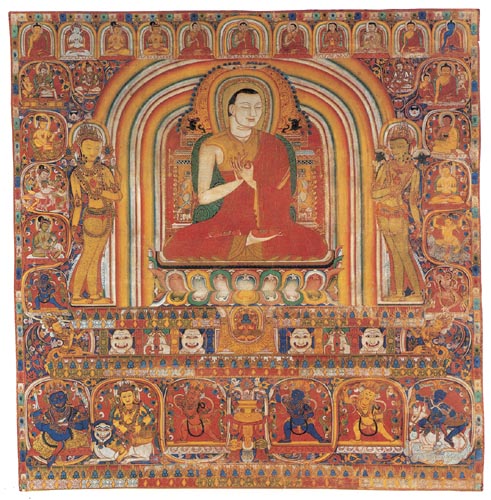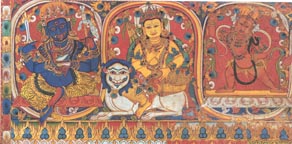| 17. Buddhist Hierarch
|

17.
Buddhist Hierarch
Central Tibet (a Kagyu monastery), early 13th century
Distemper on cloth
59.1 x 57.2 cm (231/4 x 221/2 in.)
Pritzker Collection
click on image below for 17: Detail full screen view
|

17: Detail
|
|
An enthroned Kagyu Buddhist master in the gesture of religious discourse (dharmachakra
mudra) is the subject
of this extraordinarily rendered painting. His double-lotus seat rests on a two-tier throne base of typical
pattern--except for its unusually rich surface decoration. The
throne back is supported by panels enclosing vyalas astride elephants. The ensemble is
surmounted by an aureole with foliate-tailed addorsed makaras and a Garuda with outstretched wings. Three
rainbows form an arc around the lama, and two flanking bodhisattvas stand against the outer one. From the upper
tier of the throne base, the ubiquitous stylized lions and elephants (see cat. no- 5) peer
out between struts emblazoned with vajras (ritual thunderbolts). The corners of this level are further
supported by nagarajas (serpent deities). The lower tier is held aloft by a meandering lotus scroll that emanates from
a vase set on a pair of crossed vajras at the bottom center of the composition. The twining lotus vines enclose a
series of deities that includes, from left to right, Mahakala, Vaishravana,
Hayagriva, Achala, Manjushri (probably),
and Palden Lhamo. Smaller lotus scrolls on the sides of
the painting enclose, left register, top to bottom: a siddha with his consort
(Ghantapa or Carbaripa?), the siddha Dombipa seated on his lion, a siddha dancing with two
females, the siddha Kukkuripa with his dog, and a blue Achala; right register, top to bottom: Shakyamuni with
two adepts, the siddha Naropa (probably) with begging bowl, Vajrasattva (hands crossed at chest), the siddha
Udhalipa (flying), and a dancing dakini. The top of the painting has a typical Kagyu lineage, through the
charismatic Phakmo Drupa (1110-1170), with the beard. The hierarch directly above the central figure may have been
one of Phakmo Drupa's disciples, but his identity is unclear.
The decorative motifs used in this painting are highly unusual and are based on two important Buddhist
symbols: the triratna, three jewels (see cat. no. 15), and the chintamani, the wish-fulfilling jewel. The lotus-and-jewel
frieze that typically accompanies the architectural elements of the throne is here replaced by a series of
double-lotus bases of different colors that cradle blue triratnas engulfed in golden flames. The flames extend
upward and largely obscure the upper cove moldings, whose profiles are nonetheless visible. Curiously, a
triratna surrounded by flames is
drawn on the back of the painting (see fig. 35), and another triratna, this time surrounded by golden lotus
buds, is shown on the throne cloth. The uprights of the throne are also atypically decorated with
vajras. The sides
of the painting have borders of lotus bases supporting single jewels. This same motif also surrounds the deities
in the bottom and side registers. Single and triple flaming
jewels set on lotus-petal bases are also used to represent
the lotus flowers that fill the borders and are used in decorative details throughout the painting. At the very edge of the
thanka is an interlocking border of Central
Asian derivation.1
Some of the stylistic elements in this thanka are related to those of several paintings in the exhibition, and
it is in some ways particularly close to the Buddha with Five Tathagatas (cat. no. 15). The lineage surrounding the
main figure is identical--with the exception of one of the siddhas in the right
register--to a previously published
thanka of Samvara and his consort.2 However, the painting stands apart as one of the greatest virtuoso displays of
early Tibetan painting. Its jewellike palette of rich blues, reds, whites, and yellows supplemented by softer tones is
well preserved, and gold has been used for decorative effect to an extent and with success unequaled in any
other work. Some of the pigment has been built up into tiny mounds and then gilded, creating rows of reflective
beads, a technique that is rarely used at this early date (see fig. 41).
SMK
1. The same border appears on cat. no. 15
[back]
2. Pal 1984, no. 12. [back]
|

